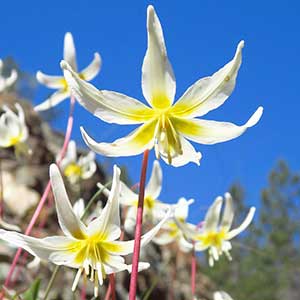Erythronium citrinum
Erythronium pluriflorum
citrus fawn lily, cream fawn lily, lemon color fawn lily, lemon fawn lily, pale fawn-lily
golden fawn-lily, manyflower fawnlily, shuteye peak fawn lily
slender, 40–50 mm, sometimes producing sessile offsets.
± ovoid, 40–75 mm.
9–15 cm;
blade mottled with irregular streaks of brown or white, lanceolate to narrowly ovate, margins ± wavy.
7–30 cm;
blade green, oblanceolate to elliptic, margins ± wavy.
12–35 cm.
8–35 cm.
1–3-flowered.
1–10-flowered.
tepals ± white, often pinkish, usually pale yellow at base, lanceolate to narrowly elliptic, 25–45 mm, inner with or without small auricles at base;
stamens 11–17 mm;
filaments linear, white or pinkish, slender, less than 0.8 mm wide;
anthers white, cream, pink, reddish, or brownish red;
style straight, white or pink, 6–10 mm;
stigma unlobed or with lobes shorter than 1 mm.
tepals yellow, bronze in age, lanceolate, 15–28 mm, not auriculate at base;
stamens 8–12 mm;
filaments yellow, slender;
anthers yellow;
style yellow, 6–8 mm;
stigma unlobed or with very short, rounded lobes shorter than 1 mm.
obovoid, 2–5 cm.
obovoid, 2–4 cm.
= 24.
Erythronium citrinum
Erythronium pluriflorum
Plants lacking auricles on inner tepals are sometimes segregated as Erythronium howellii, Howell’s fawn-lily, but they do not appear to differ from typical E. citrinum in any other characters. Erythronium citrinum intergrades with E. californicum and E. hendersonii, occasional populations or individuals displaying intermediate or recombined characteristics. Such plants from the upper Scott River drainage in Trinity County, California, which may be the result of introgression with E. hendersonii, have been recognized as variety roderickii.
(Discussion copyrighted by Flora of North America; reprinted with permission.)
Of conservation concern.
Erythronium pluriflorum is known only from Madera County.
(Discussion copyrighted by Flora of North America; reprinted with permission.)
